Towards Water Sensitive Cities in the Colorado River Basin: A Comparative Historical Analysis to Inform Future Urban Water Sustainability Transitions
Abstract
:1. Introduction
1.1. Transitions and Transition Management
1.2. Approaches to Analyzing Sustainable Water Governance
1.3. Water Sensitive Cities
1.4. Water Governance Transitions in Three Western U.S. Cases
Case Study Sites and Comparative Historical Analysis
2. Decades of Transition in Arizona, Colorado, and Nevada
2.1. 1800s: European Settlers Begin (Re)constructing Water Infrastructure and Searching for Water in the Southwest, Establishing “Sewered Cities”
2.2. Early 1900s: The National Reclamation Act is a Breakthrough in Water Policy and Governance
2.3. 1910s: Colorado River Basin States Face Water Supply Pressures, Building Momentum in Predevelopment and Takeoff Prior to the Colorado River Compact
2.4. 1920s: The Colorado River Compact as a Breakthrough Event in Water Policy
2.5. 1930s: Cities Expand Water Infrastructure, Striving to Become “Drained Cities” during the Dust Bowl
2.6. 1940s: The Central Arizona Project Enters Predevelopment, and Arizona Approves the Colorado River Compact
2.7. 1950s: Residential Water Services Expand in “Drained Cities”
2.8. 1960s: Arizona v. California and Central Arizona Project Approval Breakthroughs
2.9. 1970s: Large Infrastructure Projects Encounter Federal and Local Pushback amid Environmental Concerns, with Cities Gaining Rhetorical Support for Becoming “Waterways Cities”
2.10. 1980s: Arizona Passes a Federally-Approved Groundwater Act, and New Water Conservation Efforts Challenge the Status Quo
2.11. 1990s: Water Conservation Gains Prominence throughout the West, and the Ideas of the “Waterways City” Are Implemented with Increasing Regularity
2.12. Early 2000s: Water Conservation Efforts and Rhetoric Support for the Recognition of Limited Water Supplies Advance Incrementally
2.13. 2010s: Sustainability Emerges as a New Discourse, and Ideas Associated with “Water Sensitive Cities” Are Recognized
3. Discussion
3.1. The National Reclamation Act Facilitates the Development of Drained Cities
3.2. The Colorado River Compact and Nascent Recognition of Limited Water Resources
3.3. Backpedaling from “Limited Water” Discourse with the Boulder Canyon Project Act
3.4. Further Retreat from the Characteristics of Water Cycle Cities: Arizona v. California (1963)
3.5. Formal Steps toward Water Cycle Cities and Increased Conservation Discourse: Interstate Water Banking
3.6. Patterns and Deviations in Transitions
4. Conclusions
Acknowledgments
Author Contributions
Conflicts of Interest
References
- Elzen, B.; Wieczorek, A. Transitions towards sustainability through system innovation. Technol. Forecast. Soc. Chang. 2005, 72, 651–661. [Google Scholar] [CrossRef]
- Folke, C.; Carpenter, S.R.; Walker, B.; Scheffer, M.; Chapin, T.; Rockström, J. Resilience thinking: Integrating resilience, adaptability and transformability. Ecol. Soc. 2010, 15, Article 20. [Google Scholar] [CrossRef]
- Fleck, J. Water is for Fighting Over: And Other Myths about Water in the West; Island Press: Washington, DC, USA, 2016. [Google Scholar]
- Anderson, M.T.; Woosley, L.H., Jr. Water Availability for the Western United States—Key Scientific Challenges. Available online: https://pubs.usgs.gov/circ/2005/circ1261/pdf/C1261.pdf (accessed on 12 February 2017).
- Hirsh, R.F.; Jones, C.F. History’s contributions to energy research and policy. Energy Res. Soc. Sci. 2014, 1, 106–111. [Google Scholar] [CrossRef]
- Kemp, R.; Loorbach, D. Governance for sustainability through transition management. Proceedings of Open Meeting of Human Dimensions of Global Environmental Change Research Community, Montreal, QC, Canada, 16–18 October 2003. [Google Scholar]
- Pelling, M. Adaptation to Climate Change: From Resilience to Transformation; Routledge: London, UK; New York, NY, USA, 2011. [Google Scholar]
- Elzen, B.; Geels, F.W.; Green, K. (Eds.) System Innovation and the Transition to Sustainability: Theory, Evidence and Policy; Edward Elgar Pub.: Cheltenham, UK; Northhampton, MA, USA, 2005. [Google Scholar]
- Miller, C.A.; Richter, J.; O’Leary, J. Socio-energy systems design: A policy framework for energy transitions. Energy Res. Soc. Sci. 2015, 6, 29–40. [Google Scholar] [CrossRef]
- Rotmans, J.; Kemp, R.; van Asselt, M.; Geels, F.W.; Verbong, G.; Molendijk, K. Final Report of Study “Transitions and Transition Management” for the 4th National Environmental Policy Plan (NMP-4) of the Netherlands 2000. Available online: http://kemp.unu-merit.nl/pdf/paper%20Kemp-Loorbach-Rotmans%20on%20co-evolution.pdf (accessed on 8 December 2016).
- Avelino, F.; Rotmans, J. Power in transition: An interdisciplinary framework to study power in relation to structural change. Eur. J. Soc. Theory 2009, 12, 543–569. [Google Scholar] [CrossRef]
- Rogers, E.M. Diffusion of Innovations; Simon & Schuster: New York, NY, USA, 2010. [Google Scholar]
- Farrelly, M.; Brown, R. Rethinking urban water management: Experimentation as a way forward? Glob. Environ. Chang. 2011, 21, 721–732. [Google Scholar] [CrossRef]
- Birkland, T.A. Focusing events, mobilization, and agenda setting. J. Public Policy 1998, 18, 53–74. [Google Scholar] [CrossRef]
- Jones, B.D.; Baumgartner, F.R. The Politics of Attention: How Government Prioritizes Problems; University of Chicago Press: Chicago, IL, USA, 2005. [Google Scholar]
- Olsson, P.; Gunderson, L.H.; Carpenter, S.R.; Ryan, P.; Lebel, L.; Folke, C.; Holling, C.S. Shooting the rapids: Navigating transitions to adaptive governance of social-ecological systems. Ecol. Soc. 2006, 11, Article 18. [Google Scholar] [CrossRef]
- Voß, J.P.; Smith, A.; Grin, J. Designing long-term policy: Rethinking transition management. Policy Sci. 2009, 42, 275–302. [Google Scholar] [CrossRef]
- Rijsberman, M.A.; van de Ven, F.H. Different approaches to assessment of design and management of sustainable urban water systems. Environ. Impact Assess. Rev. 2000, 20, 333–345. [Google Scholar] [CrossRef]
- Van Leeuwen, C.J. City blueprints: Baseline assessments of sustainable water management in 11 cities of the future. Water Resour. Manag. 2013, 27, 5191–5206. [Google Scholar] [CrossRef]
- Wiek, A.; Larson, K.L. Water, people, and sustainability—A systems framework for analyzing and assessing water governance regimes. Water Resour. Manag. 2012, 26, 3153–3171. [Google Scholar] [CrossRef]
- Schneider, F.; Bonriposi, M.; Graefe, O.; Herweg, K.; Homewood, C.; Huss, M.; Kauzlaric, M.; Liniger, H.; Rey, E.; Reynard, E.; et al. Assessing the sustainability of water governance systems: The sustainability wheel. J. Environ. Plan. Manag. 2015, 58, 1577–1600. [Google Scholar] [CrossRef]
- Larson, K.L.; Wiek, A.; Withycombe Keeler, L. A comprehensive sustainability appraisal of water governance in Phoenix, AZ. J. Environ. Manage. 2013, 116, 58–71. [Google Scholar] [CrossRef] [PubMed]
- Bos, J.J.; Brown, R.R.; Farrelly, M.A. Building networks and coalitions to promote transformational change: Insights from an Australian urban water planning case study. Environ. Innov. Soc. Transit. 2015, 15, 11–25. [Google Scholar] [CrossRef]
- Brown, R.R.; Keath, N.; Wong, T.H.F. Urban water management in cities: Historical, current and future regimes. Water Sci. Technol. 2009, 59, 847–855. [Google Scholar] [CrossRef] [PubMed]
- Wong, T.; Brown, R. Transitioning to Water Sensitive Cities: Ensuring Resilience through a New Hydro-Social Contract. Available online: https://web.sbe.hw.ac.uk/staffprofiles/bdgsa/11th_International_Conference_on_Urban_Drainage_CD/ICUD08/pdfs/638.pdf (accessed on 20 December 2016).
- Brown, R.R.; Clarke, J.M. Transition to Water Sensitive Urban Design: The Story of Melbourne, Australia. Available online: http://www.monash.edu.au/fawb/publications/final-transition-doc-rbrown-29may07.pdf (accessed on 14 November 2016).
- Dobbie, M.F.; Brown, R.R.; Farrelly, M.A. Risk governance in the water sensitive city: Practitioner perspectives on ownership, management and trust. Environ. Sci. Policy 2016, 55, 218–227. [Google Scholar] [CrossRef]
- U.S. Bureau of Reclamation. Reclamation Managing Water in the West: Colorado River Basin Water Supply and Demand Study; Executive Summary. Available online: https://www.usbr.gov/watersmart//bsp/docs/finalreport/ColoradoRiver/CRBS_Executive_Summary_FINAL.pdf (accessed on 12 November 2016).
- Christensen, N.S.; Wood, A.W.; Voisin, N.; Lettenmaier, D.P.; Palmer, R.N. The effects of climate change on the hydrology and water resources of the Colorado River basin. Clim. Chang. 2004, 62, 337–363. [Google Scholar] [CrossRef]
- Woodhouse, C.A.; Meko, D.M.; MacDonald, G.M.; Stahle, D.W.; Cook, E.R. A 1,200-year perspective of 21st century drought in southwestern North America. Proc. Natl. Acad. Sci. USA 2010, 107, 21283–21288. [Google Scholar] [CrossRef] [PubMed]
- U.S. Bureau of Reclamation. The Law of the River. Available online: https://www.usbr.gov/lc/region/g1000/lawofrvr.html (accessed 2 March 2017).
- Yin, R.K. Case study research: Design and methods. In Essential Guide to Qualitative Methods in Organizational Research, 4th ed.; SAGE: Thousand Oaks, CA, USA, 2009. [Google Scholar]
- Mahoney, J.; Rueschemeyer, D. Comparative Historical Analysis in the Social Sciences; Cambridge University Press: Cambridge, UK, 2003. [Google Scholar]
- Mahoney, J.; Rueschemeyer, D. Comparative Historical Analysis: Achievement and agendas. In Comparative Historical Analysis in the Social Sciences; Mahoney, J., Rueschemeyer, D., Eds.; Cambridge University Press: Cambridge, UK, 2003; pp. 3–38. [Google Scholar]
- Fouquet, R.; Pearson, P.J.G. Past and prospective energy transitions: Insights from history. Energy Policy 2012, 50, 1–7. [Google Scholar] [CrossRef]
- Goldstone, J. Comparative historical analysis and knowledge accumulation in the study of revolutions. In Comparative Historical Analysis in the Social Sciences; Mahoney, J., Rueschemeyer, D., Eds.; Cambridge University Press: Cambridge, UK, 2003; pp. 41–90. [Google Scholar]
- Turnheim, B.; Geels, F.W. Regime destabilisation as the flipside of energy transitions: Lessons from the history of the British coal industry (1913–1997). Energy Policy 2012, 50, 35–49. [Google Scholar] [CrossRef]
- Cordalis, A.; Cordalis, D. Indian Water Rights: How Arizona v. California Left an Unwanted Cloud over the Colorado River Basin. Ariz. J. Environ. Law Policy 2014, 5, 333–362. [Google Scholar]
- Colorado River Research Group. Tribes and Water in the Colorado River Basin. Available online: http://scholar.law.colorado.edu/cgi/viewcontent.cgi?article=1177&context=books_reports_studies (accessed on 17 October 2016).
- Shove, E.; Walker, G. Caution! Transitions Ahead: Politics, Practice, and Sustainable Transition Management. Environ. Plan. A 2007, 39, 763–770. [Google Scholar] [CrossRef]
- Haury, E.W. Hohokam, Desert Farmers & Craftsmen; University of Arizona Press: Tucson, AZ, USA, 1976. [Google Scholar]
- Woodbury, R.B. A reappraisal of Hohokam irrigation. Am. Anthropol. 1961, 63, 550–560. [Google Scholar] [CrossRef]
- Worster, D. Rivers of Empire: Water, Aridity, and the Growth of the American West, 1st ed.; Pantheon Books: New York, NY, USA, 1985. [Google Scholar]
- Hundley, N. Water and the West: The Colorado River Compact and the Politics of Water in the American West, 2nd ed.; University of California Press: Oakland, CA, USA, 2009. [Google Scholar]
- Welden, F. History of Water Law in Nevada and the Western States. Available online: https://www.leg.state.nv.us/Division/Research/Publications/Bkground/BP03-02.pdf (accessed on 15 September 2016).
- Pisani, D.J. Water and American Government: The Reclamation Bureau, National Water Policy, and the West, 1902-1935, 1st ed.; University of California Press: Oakland, CA, USA, 2002. [Google Scholar]
- U.S. Bureau of Reclamation. The Reclamation Act 1902. Available online: https://www.usbr.gov/lc/region/programs/contracts/Legislation.pdf (accessed on 12 August 2016).
- Salt River Project. The Salt River Project of Arizona: Identical with the Salt River Project Agricultural Improvement and Power District. Available online: http://uair.library.arizona.edu/system/files/usain/download/azu_fe_eph_qp_srp_12_w.pdf (accessed on 23 October 2016).
- Limerick, P.N.; Hanson, J.L. A Ditch in Time: the City, the West, and Water; Fulcrum Pub.: Golden, CO, USA, 2012. [Google Scholar]
- Land, B.; Land, M. A Short History of Las Vegas; University of Nevada Press: Reno, NV, USA, 2004. [Google Scholar]
- Miller, C. Water in the West: A High Country News Reader, 1 ed.; Oregon State University Press: Corvallis, OR, USA, 2000. [Google Scholar]
- Sheridan, T.E. Southwest Center Series: Arizona: A History, Revised Edition; University of Arizona Press: Tucson, AZ, USA, 2012. [Google Scholar]
- Frankfurter, F.; Landis, J.M. The compact clause of the constitution. A study in interstate adjustments. Yale Law J. 1925, 34, 685–758. [Google Scholar] [CrossRef]
- McKee, T.B.; Doesken, N.J.; Kleist, J.; Shrier, C.J.; Stanton, W.P. A History of Drought in Colorado: Lessons Learned and What Lies Ahead. Available online: https://ccc.atmos.colostate.edu/pdfs/ahistoryofdrought.pdf (accessed on 14 October 2016).
- Nies, J. Unreal City: Las Vegas, Black Mesa, and the Fate of the West; Nation Books: Boulder, MT, USA, 2014. [Google Scholar]
- Connall, D.D.J. A History of the Arizona Groundwater Management Act. Ariz. State Law J. 1982, 1982, 313–344. Available online: http://heinonline.org/HOL/LandingPage?handle=hein.journals/arzjl1982&div=23&id=&page= (accessed on 17 October 2016).
- Elliott, R.R.; Rowley, W.D. History of Nevada, 2nd ed.; University of Nebraska Press: Lincoln, NE, USA, 1987. [Google Scholar]
- U.S. Supreme Court. Arizona v. California 373 U.S. 546 (1963). Available online: https://supreme.justia.com/cases/federal/us/373/546/ (accessed on 12 September 2016).
- MacDonnell, L. Arizona v. California: Its Meaning and Significance for the Colorado River and Beyond After Fifty Years. Ariz. J. Environ. Law Policy 2013, 4, 89–116. Available online: http://www.ajelp.com/articles/macdonnell-arizona-v-california-its-meaning-and-significance/ (accessed on 7 December 2016). [CrossRef]
- Jiang, N.; Martin, S.; Morton, J.; Murphy, S. The Bathtub Ring. Shrinking Lake Mead: Impacts on Water Supply, Hydropower, Recreation and the Environment. Available online: http://scholar.law.colorado.edu/cgi/viewcontent.cgi?article=1154&context=books_reports_studies (accessed on 8 November 2016).
- Rogers, J.; Moonin, E. Recent Southern Nevada Water History and Water Education. Proceedings of World Environmental and Water Resources Congress, Portland, OR, USA, 1–5 June 2014. [Google Scholar]
- Kyl, J.L. The 1980 Arizona Groundwater Management Act: From Inception to Current Constitutional Challenge. Univ. Colo. Law Rev. 1981, 53, 471–503. [Google Scholar]
- Sovocool, K.A.; Morgan, M.; Bennett, D. An in-depth investigation of xeriscape as a water conservation measure. J. Am. Water Works Assoc. 2006, 98, 82–93. [Google Scholar]
- Colby, B.G.; Jacobs, K.L. Arizona Water Policy: Management Innovations in an Urbanizing, Arid Region. Available online: https://arizona.pure.elsevier.com/en/publications/arizona-water-policy-management-innovations-in-an-urbanizing-arid (accessed on 15 November 2016).
- Castle, S.L.; Thomas, B.F.; Reager, J.T.; Rodell, M.; Swenson, S.C.; Famiglietti, J.S. Groundwater depletion during drought threatens future water security of the Colorado River Basin. Geophys. Res. Lett. 2014, 41. [Google Scholar] [CrossRef] [PubMed]
- Vano, J.A.; Udall, B.; Cayan, D.R.; Overpeck, J.T.; Brekke, L.D.; Das, T.; Hartmann, H.C.; Hidalgo, H.G.; Hoerling, M.; McCabe, G.J.; et al. Understanding Uncertainties in Future Colorado River Streamflow. Bull. Am. Meteorol. Soc. 2013, 95, 59–78. [Google Scholar] [CrossRef]
- Hirt, P.; Gustafson, A.; Larson, K. The Mirage in the Valley of the Sun. Environ. Hist. 2008, 13, 482–514. [Google Scholar] [CrossRef]
- Lewis, W.M. (Ed.) Water and Climate in the Western United States; University Press of Colorado: Boulder, CO, USA, 2003. [Google Scholar]
- Roosevelt, T. Message of The President of The United States Communicated to the Two Houses of Congress 1902. Available online: https://catalog.hathitrust.org/Record/100855040 (accessed on 9 October 2016).
- Laidlaw, M.A.; Filippelli, G.M.; Sadler, R.C.; Gonzales, C.R.; Ball, A.S.; Mielke, H.W. Children’s blood lead seasonality in flint, Michigan (USA), and soil-sourced lead hazard risks. Int. J. Environ. Res. Public Health 2016, 13. [Google Scholar] [CrossRef] [PubMed]
- Brown, R.R.; Farrelly, M.A.; Loorbach, D.A. Actors working the institutions in sustainability transitions: The case of Melbourne’s stormwater management. Glob. Environ. Chang. 2013, 23, 701–718. [Google Scholar] [CrossRef]
- Barnett, T.P.; Pierce, D.W.; Hidalgo, H.G.; Bonfils, C.; Santer, B.D.; Das, T.; Bala, G.; Wood, A.W.; Nozawa, T.; Mirin, A.A.; et al. Human-induced changes in the hydrology of the western United States. Science 2008, 319, 1080–1083. [Google Scholar] [CrossRef] [PubMed]
- Wiek, A.; Binder, C.; Scholz, R.W. Functions of scenarios in transition processes. Futures 2006, 38, 740–766. [Google Scholar] [CrossRef]
- Kemp, R.; Rotmans, J. Managing the transition to sustainable mobility. In Transitions in a Globalising World; Martens, W.J.M., Rotmans, J., Eds.; Swets & Zeitlinger: Lisse, The Netherlands; Exton, PA, USA, 2002; pp. 137–167. [Google Scholar]
- Miller, T.; Wiek, A.; Sarewitz, D.; Robinson, J.; Olsson, L.; Kriebel, D.; Loorbach, D. The future of sustainability science: A solutions-oriented research agenda. Sustain. Sci. 2014, 9, 239–246. [Google Scholar] [CrossRef]
- Avery, C.; Consoli, C.; Glennon, R.; Megdal, S.B. Good Intentions, Unintended Consequences: The Central Arizona Groundwater Replenishment District; Social Science Research Network: Rochester, NY, USA, 2007. [Google Scholar]
- Vincent, J.A. What Lies Beneath: The Inherent Dangers of the Central Arizona Groundwater Replenishment District. Ariz. State Law J. 2006, 38, 857–880. [Google Scholar]
- Morris, R.L.; Devitt, D.A.; Crites, A.M.; Borden, G.; Allen, L.N. Urbanization and Water Conservation in Las Vegas Valley, Nevada. J. Water Resour. Plan. Manag. 1997, 123, 189–195. [Google Scholar] [CrossRef]
- Peters, B. Analyzing the Reservoir Beneath Our Feet: Denver Water’s Aquifer Storage and Recovery Pilot Project. Proceedings of 2016 NGWA Groundwater Summit, Denver, CO, USA, 24–27 April 2016. [Google Scholar]
- Kenney, D.S.; Goemans, C.; Klein, R.; Lowrey, J.; Reidy, K. Residential Water Demand Management: Lessons from Aurora, Colorado. J. Am. Water Resour. Assoc. 2008, 44, 192–207. [Google Scholar] [CrossRef]
- Gober, P.; Kirkwood, C.W. Vulnerability assessment of climate-induced water shortage in Phoenix. Proc. Natl. Acad. Sci. USA 2010, 107, 21295–21299. [Google Scholar] [CrossRef] [PubMed]
- Gober, P.; Kirkwood, C.W.; Balling, R.C., Jr.; Ellis, A.W.; Deitrick, S. Water Planning Under Climatic Uncertainty in Phoenix: Why We Need a New Paradigm. Ann. Assoc. Am. Geogr. 2010, 100, 356–372. [Google Scholar] [CrossRef]
- Ranatunga, T.; Tong, S.T.Y.; Sun, Y.; Yang, Y.J. A total water management analysis of the Las Vegas Wash watershed, Nevada. Phys. Geogr. 2014, 35, 220–244. [Google Scholar] [CrossRef]
- Arizona State Arizona Population Projections. 2016. Available online: https://population.az.gov/population-projections (accessed on 17 August 2016).
- Nevada State Nevada Population Projections. 2016. Available online: http://nsla.nv.gov/Library/StateDataCenter/Nevada_Population_Estimates_and_Projections/ (accessed on 17 August 2017).
- Gleick, P.H. Roadmap for sustainable water resources in southwestern North America. Proc. Natl. Acad. Sci. USA 2010, 107, 21300–21305. [Google Scholar] [CrossRef] [PubMed]
- Garfin, G.; Jardine, A.; Merideth, R.; Black, M.; LeRoy, S. Assessment of Climate Change in the Southwest United States: A Report Prepared for the National Climate Assessment; Island Press: Washington, DC, USA, 2013. [Google Scholar]
- Rosenberg, N.J.; Brown, R.A.; Izaurralde, R.C.; Thomson, A.M. Integrated assessment of Hadley Centre (HadCM2) climate change projections on agricultural productivity and irrigation water supply in the conterminous United States: I. Climate change scenarios and impacts on irrigation water supply simulated with the HUMUS model. Agric. For. Meteorol. 2003, 117, 73–96. [Google Scholar]
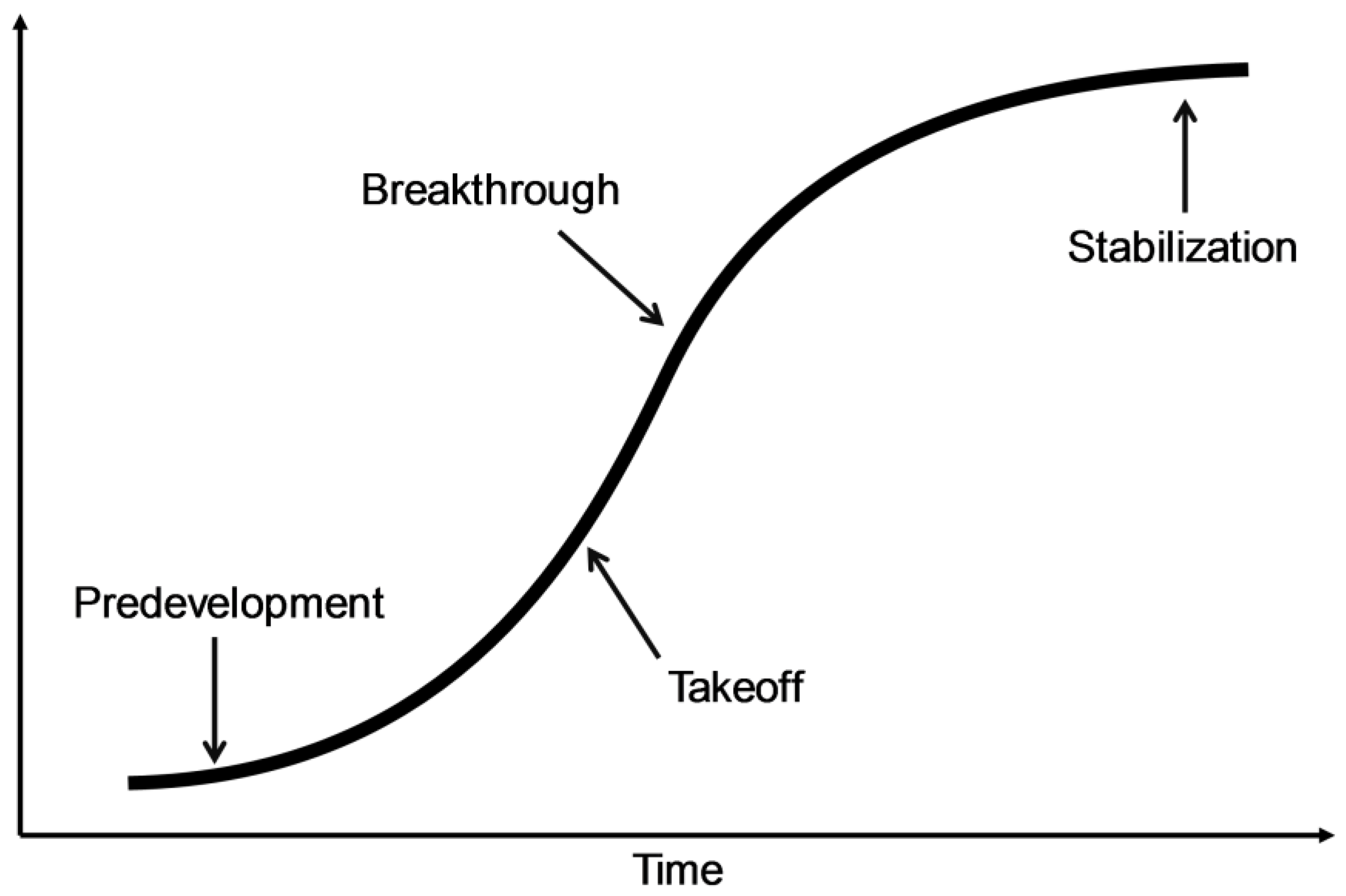
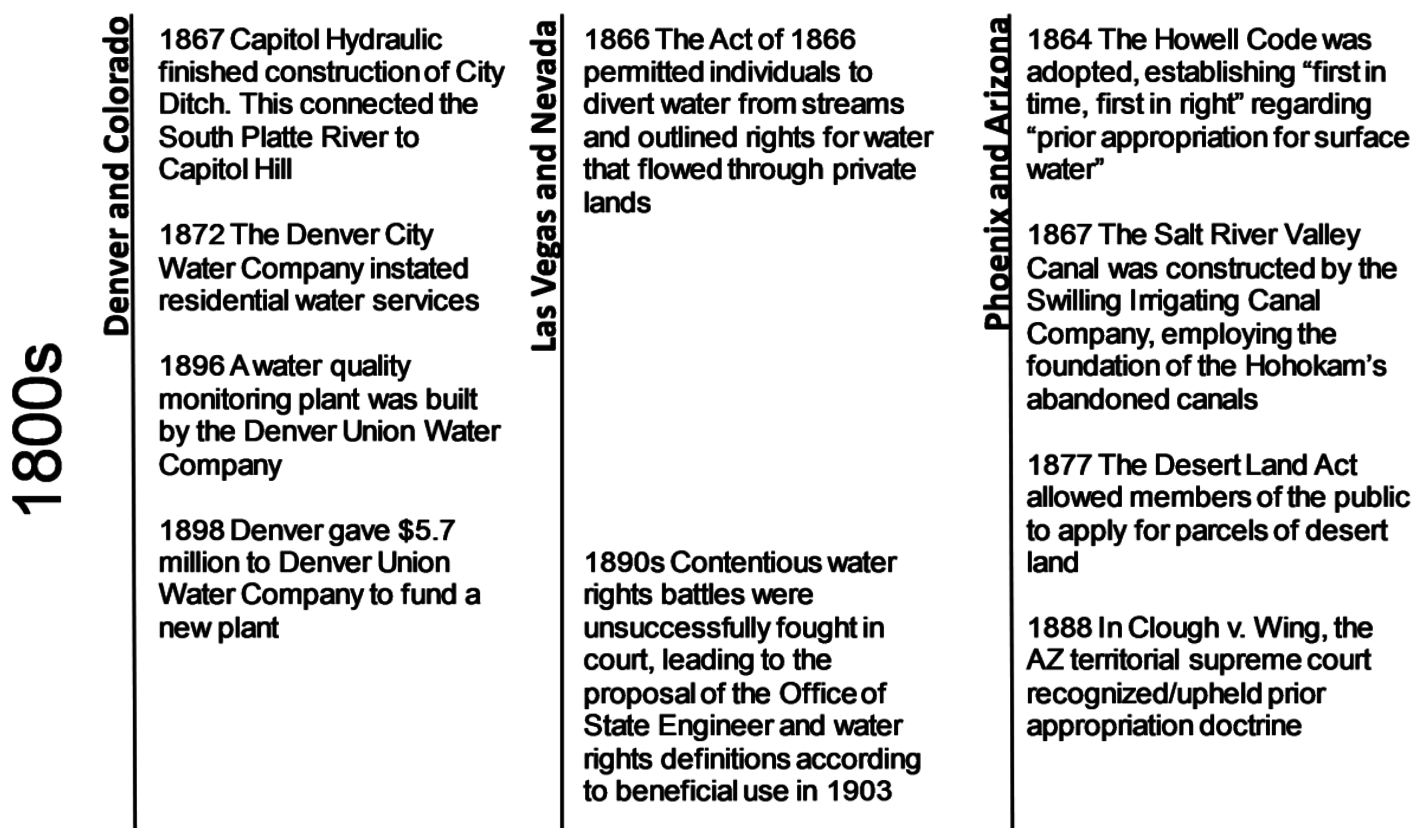
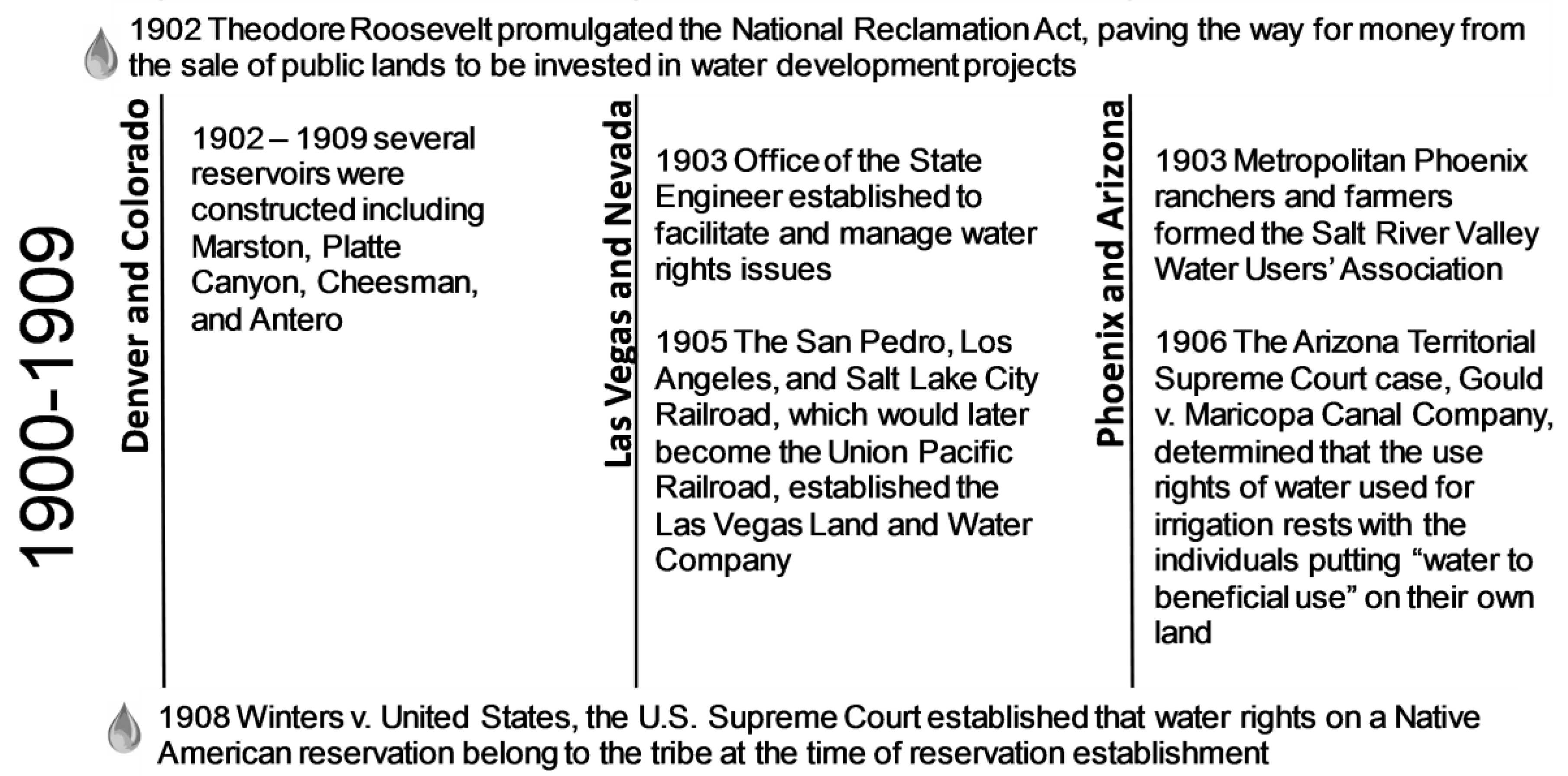



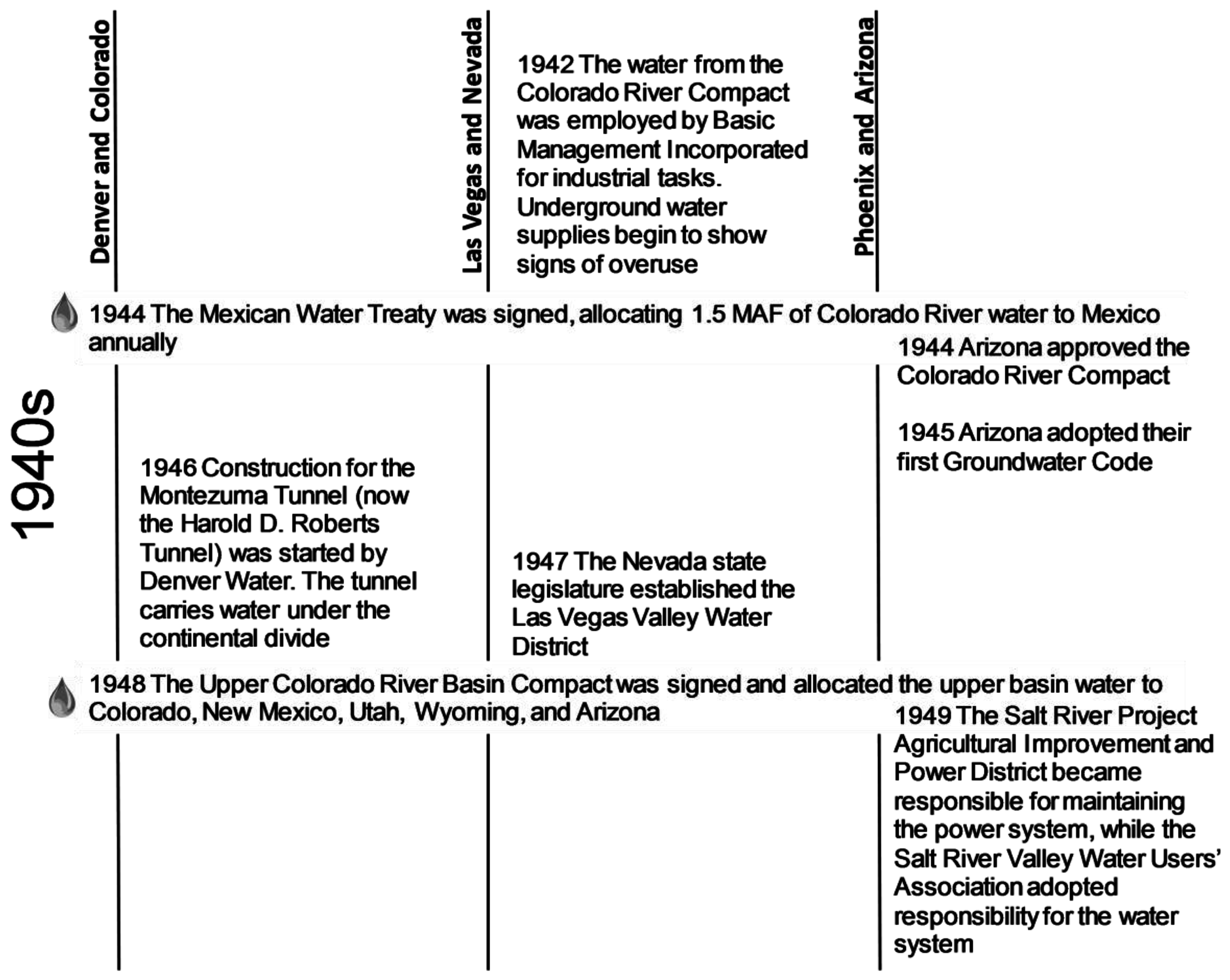
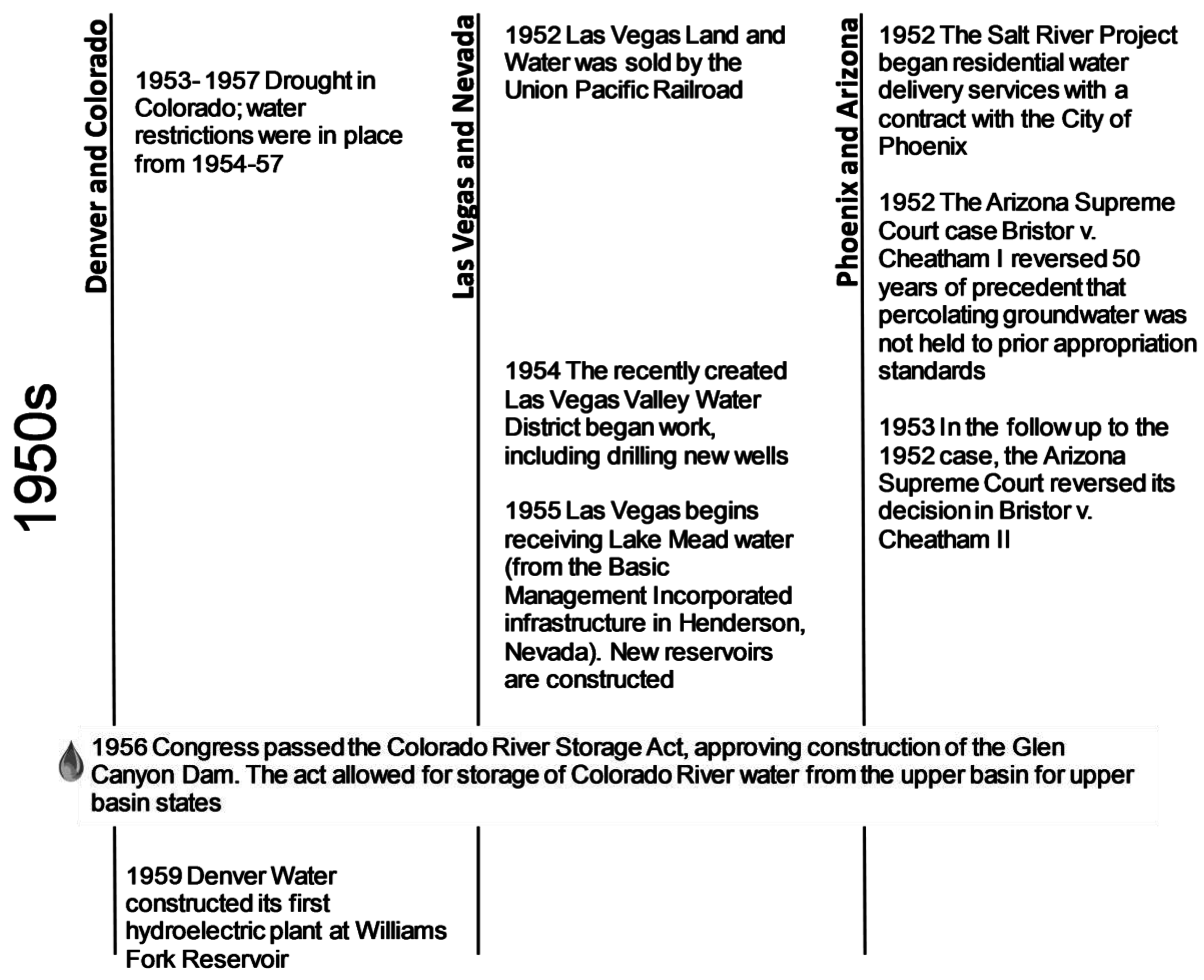

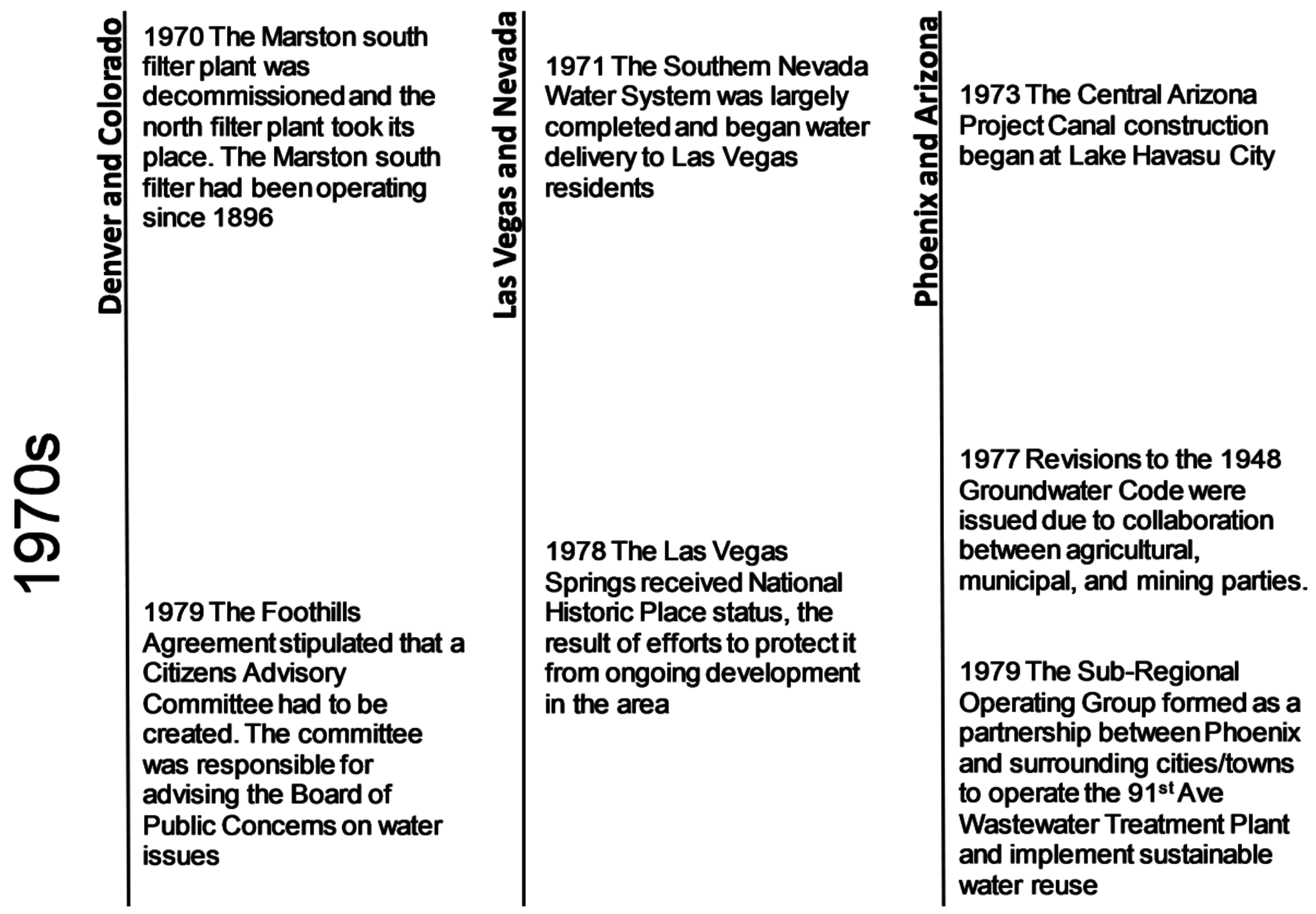
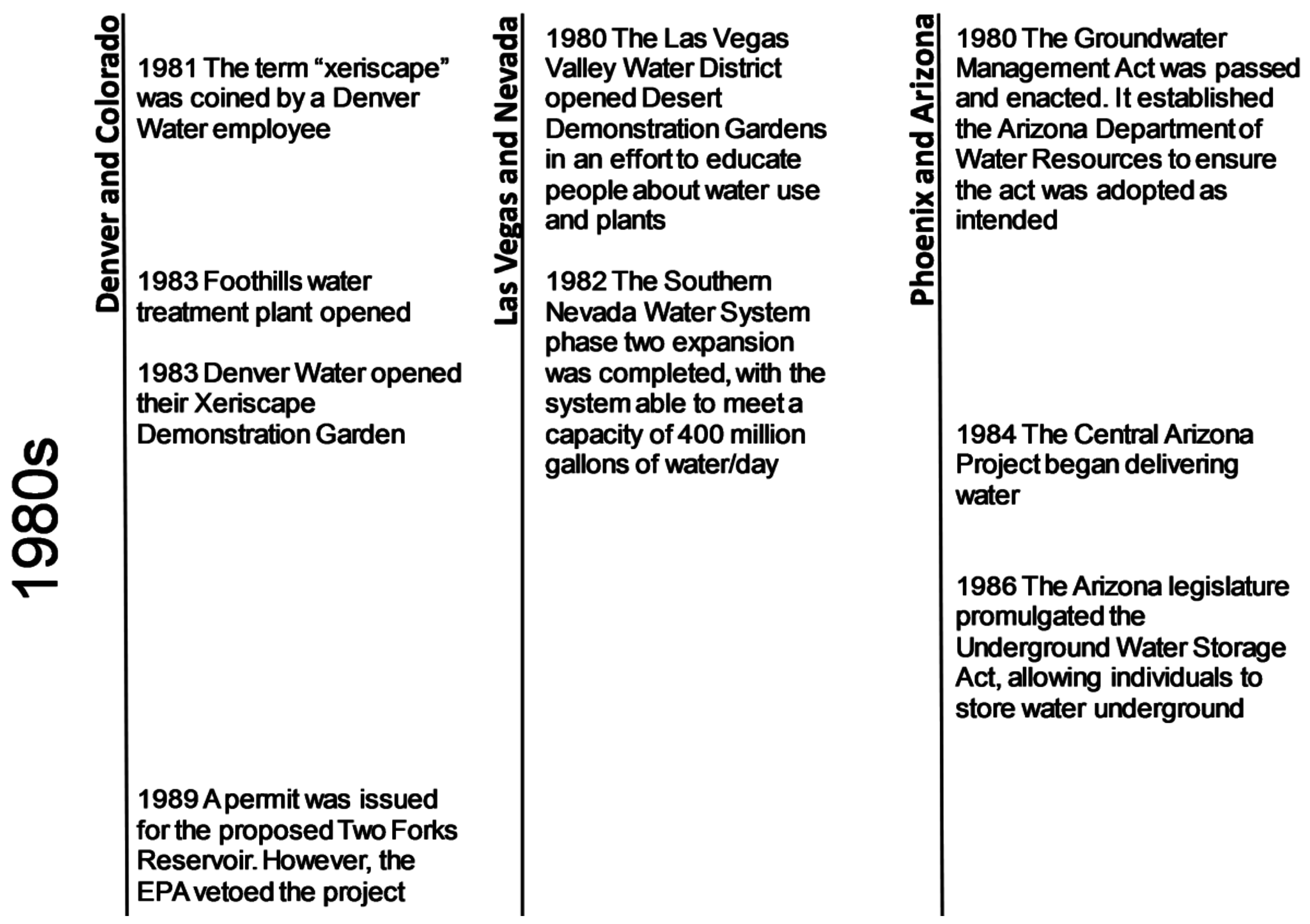

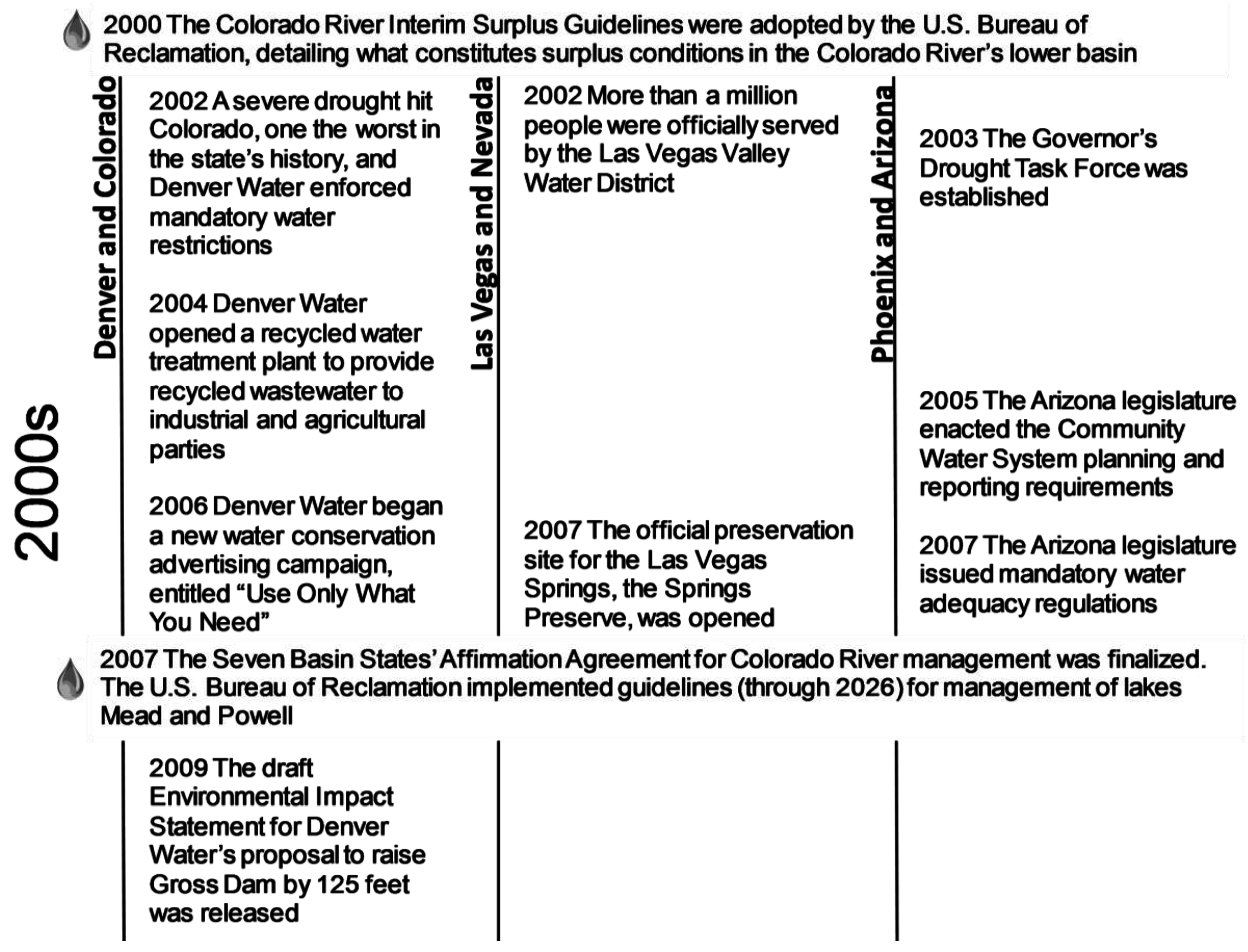

| Year | State(s) | Transition “Breakthrough” Events | Reasons/Catalysts | Stage in the Water Sensitive Cities Framework [24] |
|---|---|---|---|---|
| 1902 | CO, NV, AZ | Theodore Roosevelt promulgated the National Reclamation Act | Mounting political and social pressure to support western U.S. development | |
| 1922 | CO, NV, AZ | The Colorado River Compact was formulated by the seven basin states | Political entrepreneur | |
| 1928 | CO, NV, AZ | The Boulder Canyon Project Act was passed by Congress, approving construction of the (renamed) Hoover Dam | Technological innovation; political pressure to expand water supplies in the western U.S. | |
| 1963 | CO, NV, AZ | The United States Supreme Court’s decree in the case Arizona v. California (1963) upheld the allocation of lower basin water to the lower basin states outlined in the 1928 Boulder Canyon Project Act | Results from previous Arizona v. California cases | |
| 1999 | CO, NV, AZ | The Secretary of the Interior issued regulations allowing interstate water banking among the lower basin states | Technological innovation in water storage; pressure from states to formalize water conservation efforts | |
| 1932–1935 | CO | Eleven Mile Canyon Dam and Moffat Water Tunnel Diversion Projects were constructed | Dust Bowl drought event and President Roosevelt’s New Deal’s Public Works Administration Program | In progress towards becoming a drained city |
| 1997 | CO | Denver Water issued a new Conservation Master Plan including water conservation strategies | Drought, social/ideological shift in public’s views of conservation | Waterways city with rhetoric support for the water cycle city from water providers and at the city and state policy level |
| 2006 | CO | Denver Water began a new water conservation advertising campaign, entitled “Use Only What You Need” | Prolonged drought conditions | |
| 1955 | NV | Las Vegas began receiving Lake Mead water | Political and social pressure to limit reliance on declining groundwater | Drained city |
| 1991 | NV | The Southern Nevada Water Authority was established | Political and social pressure | Waterways city with regular environmental regulations |
| 1995 | NV | The first conservation plan for the Las Vegas region was developed | Pressure from citizens to consider future water supplies and sustainability | Rhetoric support for the water cycle city from citizen and environmental groups |
| 1864 | AZ | The Howell Code was adopted, establishing “first in time, first in right” regarding “prior appropriation for surface water” | Political pressure to adopt formal water rights similar to established western states | Water supply city |
| 1944 | AZ | Arizona ratified the Colorado River Compact | Political pressure and fear of losing water supplies to Mexico | Drained city |
| 1980 | AZ | The Groundwater Management Act was promulgated, formally prioritizing conservation efforts prior to many western states | External political pressure; perceived threat of federal funding losses for water development projects | Drained city progressing towards waterways city with increased environmental regulation |
| 1993 | AZ | The Central Arizona Groundwater Replenishment District was established | Political pressure related to the impending implementation of assured water supply rules | Rhetoric support for the water cycle city from citizens and other stakeholders |
© 2017 by the authors. Licensee MDPI, Basel, Switzerland. This article is an open access article distributed under the terms and conditions of the Creative Commons Attribution (CC BY) license (http://creativecommons.org/licenses/by/4.0/).
Share and Cite
Sullivan, A.; White, D.D.; Larson, K.L.; Wutich, A. Towards Water Sensitive Cities in the Colorado River Basin: A Comparative Historical Analysis to Inform Future Urban Water Sustainability Transitions. Sustainability 2017, 9, 761. https://doi.org/10.3390/su9050761
Sullivan A, White DD, Larson KL, Wutich A. Towards Water Sensitive Cities in the Colorado River Basin: A Comparative Historical Analysis to Inform Future Urban Water Sustainability Transitions. Sustainability. 2017; 9(5):761. https://doi.org/10.3390/su9050761
Chicago/Turabian StyleSullivan, Abigail, Dave D. White, Kelli L. Larson, and Amber Wutich. 2017. "Towards Water Sensitive Cities in the Colorado River Basin: A Comparative Historical Analysis to Inform Future Urban Water Sustainability Transitions" Sustainability 9, no. 5: 761. https://doi.org/10.3390/su9050761





